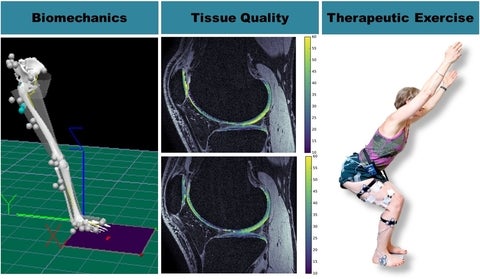Biomechanics: abnormal and cumulative loading
Much biomechanical research in the knee has focused on abnormal loading, represented by the peak knee adduction moment (KAM). Professor Maly introduced the cumulative knee adductor load (CKAL) which integrates abnormal and repetitive loading to reflect the time dependent nature of articular cartilage deformation, which varies with compression in osteoarthritis (OA).
Moving forward, the Mobilize Lab will develop a knee joint model that investigates how altered tissue properties associated with knee OA affect the joint contact forces at the knee. Experimental data of muscle and cartilage properties, as well as joint morphology specific to knee OA, will be integrated into an existing knee model (OpenSim). Magnetic resonance imaging (MRI) scans in samples with knee OA will inform OA muscle and cartilage properties and joint morphology.
Recently we showed that abnormal mechanics in the presence of obesity was a potent predictor of cartilage loss in people with knee OA. See article in the Journal of Orthopedic Research.
Characterizing knee tissue quality in vivo
The Mobilize Lab is using advanced imaging techniques to examine muscle, fat, cartilage morphology, and cartilage composition in and around the knee in several ways:
- Examining the relationships of muscle function (i.e., knee extensor maximum isometric contraction, knee extensor power, and knee co-activation) with cartilage morphology and composition
- Exploring the adaptive responses of cartilage morphology and composition to an exercise program
- Collaborating with Professor Callaghan and Professor Quadrilatero in an ex vivo investigation of the impact of different work/rest ratios on cartilage morphology, histology, and material properties
Does exposing a healthy knee joint to exercise improve cartilage? The Globe and Mail featured some of our interesting data in an article on osteoarthritis and exercise showing that maintaining activity is likely important.
Using biomechanics to design therapeutic exercise
Given the evidence linking KAM with cartilage degradation, we developed a biomechanical exercise program that minimized the KAM and maximized leg muscle activity in women with healthy and OA knees. We have piloted this exercise program among women with symptomatic knee OA, as well as young and old workers in a variety of workplace settings.
The Mobilize Lab is hoping to expand the sample size of our 3-arm parallel randomized controlled trial in order to demonstrate the benefits of biomechanical exercise for individuals with knee OA. We also aim to broaden our workplace intervention trials as few studies have investigated strategies to improve productivity among workers with arthritis.
If you have knee OA and you are looking for some tips, check out this article on yoga strengthening to minimize the knee adduction moment.


